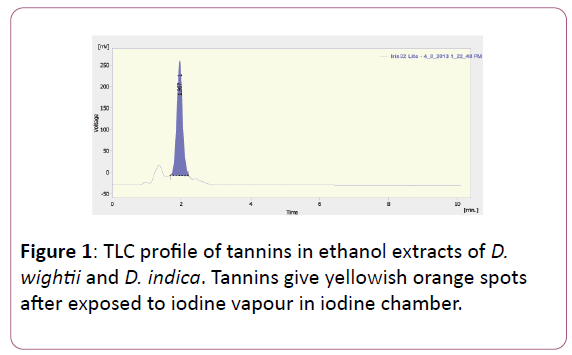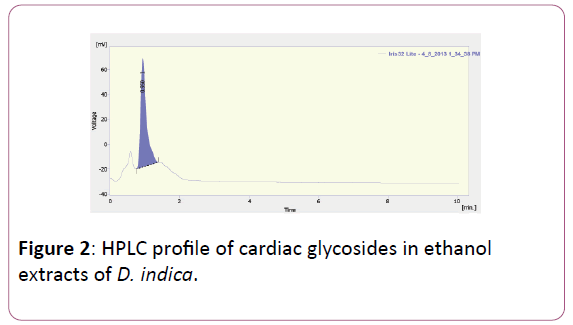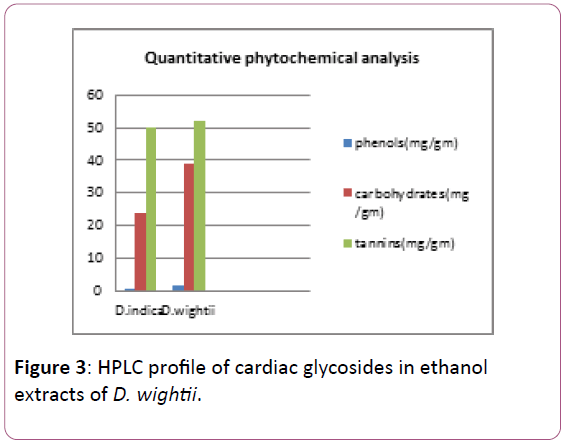Keywords
Drimia; Tannins; Cardiac glycosides; Alkaloids; Phytochemical; Heart disease; HPLC
Introduction
Genus Drimia (Urgenia) belongs to family Hyacinthaceae is represented by about 100 species in the world. About 7 species are recorded in India of which 5 occur in Northern Western Ghats. Drimia polyantha and Drimia razii are endemic to Northern Western Ghats while Drimia indica, Drimia wightii and Drimia coromandeliana are widely distributed throughout Peninsular India. The bulbs of Drimia species are valued for cardiotonic glycosides, which are used in medicine. Cardiac disease is an important cause of premature death in industrialized countries. It is estimated that cardiac disease will emerge as single largest contributor to morbidity in India accounting for nearly one third of total death in near future. Cardiac glycosides have been used as main therapeutic agents in the treatment of congestive cardiac failure. However, the danger of cardiac glycosides intoxication is well documented and doubts have been expressed about their effectiveness. Cardiac glycosides intoxication with digitalis, a narrow therapeutic index drug, remains a common clinical problem. Indian squills are of significant values in medicine. The bulbs are also used for sizing paper. In recent paper, cytotoxicity efficiency of paper of Urgenia sps identified that it possess this compound unique character to target and attack cancer cell with less severe toxicity. In Yunani medicines, Urgenia indica is used as one of the active ingredients and these are used for the treatment of skin diseases as well as internal pains and scabies. Some herbal products, which are used as tumour suppressants also contain Urgenia indica. Urgenia species has a powerful digitalis like cardiac effect. It is utilized as a source of natural cardiac steroid product in traditional remedial and veterinary medicine as well. The glycoside consists of various categories of secondary metabolites bound to mono- or oligosaccharides or to uronic acid. The saccharide or uronic acid part is called gylcone and the other part aglycone. The aglycones of cardiac glycosides have a steroidal structure. Their effect is inhibition of Na+/K+/ATPase pumps in the cell membranes. These pumps are concentrated in and critical for the functioning of the cardiac cells and the effect from this compound are very pronounced in heart resulting in increased contractility and reduced rate. The wild Drimia species are promising source of glycosides. Therefore, comparative study on glycoside content of various species will be useful in identification of promising species for glycosides. Therefore, phytochemical analysis of various species of Drimia for cardio tonic glycosides is worth of investigation.
Classification
Class: Magnoliopsida
Subclass: Liliidae
Suborder: Lilianae
Order: Asparagales
Suborder: Asparagineae
Family: Hyacinthaceae
Genus: Drimia
Species: indica
Review of Literature
Methanol-dichloromethane and methanol-ethanol extract were prepared. Mueller- Hinton broth was used for S. aureus and K. pneumonia whereas sabouraud dextrose broth for C. albicans. The microbial susceptibility assay was based on microplate method. Both shows inhibition growth of Staphylococcus aureus, Klebsiella pneumoniae and Candida albican. While comparing Du Toit et al. observed that methanol-dichloromethane extract growth suppression reach high doses. In cytotoxic effect of U. maritima aqueous extract on malignant human neuroblastoma SH-SY5Y cell line, Cell titer 96 aqueous assays is used [1]. Higher the concentration of U. maritima aqueous extract lower the viability of both cell neuroblastoma and neuro-like cell progressively. Elghuol et al. also observed that susceptibility of neuroblastoma cells was significantly higher than neuro-like cell [2].
Antibacterial activity of U. indica was tested by disc diffusion method. In results, it was observed that it was active on few bacteria, but not against all of the test bacteria and showed various degree of zone of inhibition. Cytotoxic effect was determined using (microculture tetrazolium) MTT assay where it is observed that U. maritima show antimalarial activities [3]. Anti-inflammatory activity of U. indica was evaluated in rats (female) against carrageenan induced edema i.e., using plethysmographic method. The observation show inhibition of carrageenan induces edema in rats [4].
Materials and Methods
Plant material
Drimia indica and Drimia wightii were collected from Shivaji University, Kolhapur, Maharastra. The leaves and root were cut out from the bulb of plant and then weighed 20 gm for Drimia indica (fresh weight). Similarly Drimia wightii weighed 8 gm (fresh weight). The bulb of the plants was sliced transversely and was subjected to dry under the shade for 15 days. After drying, the weight was 4.230 gm for Drimia indica whereas for Drimia wightii it was 2.002 gm. Dried crispy pieces were finally crushed to form powder.
Preparation of extraction
The air dried powdered plant material was extracted with ethanol. The powdered plants of each sample were weighed exactly 500 mg and grind it with a mortar and pestle in 10 time volume of 80% ethanol.
Phytochemical analysis
Qualitative analysis: Chemical test were carried out on the ethanol aqueous extract using procedures to identify the phytochemicals as described.
1. Test for carbohydrates: 2 ml of extract in test tube of Molisch’s reagent and few drops of concentrated sulphuric acid were added. Purple colour formation indicated the presence of carbohydrates.
2. Test for tannins: 1 ml of extract is taken in a test tube and to this 2 ml of 5% ferric chloride was added. Formation of greenish black colour is observed, which indicate the presence of tannins.
3. Test for alkaloids: 2 ml of extract was taken in test tube. To this, 2 ml of concentrated hydrochloric acid were added. Formation of green colour observed, which indicate the presence of alkaloids.
4. Test for phenols: 1 ml of extract was taken in test tube. To this, 2 ml of distilled water followed by few drops of 10% ferric chloride were added. Formation of green colour is observed, which indicate the presence of phenols.
5. Test for cardiac glycosides: 0.5 ml of extract is taken in test tube. To this, 2 ml of glacial acetic acid and few drop of 5% ferric chloride solution were added followed by the addition of 2 ml concentrated sulphuric acid along the side of the test tube. Reddish brown colour appeared at the junction of the 2 liquid layer indicate the presence of cardiac glycosides [5,6].
TLC Method (Thin Layer Chromatography)
1. Phenols: 10 ml of 80% ethanol extract sample was concentrated by evaporation. TLC plates were prepared by using Silica GEL-G as adsorbent. The procedure was carried with solvent acetic acid: chloroform (1:9), which is followed by spraying with dilute Folin-Ciocalteu reagent (1:1 with water) followed by spraying with 20% Na2CO3 solution.
2. Alkaloids: TLC plates were prepared by using Silica GEL-G as adsorbent. The procedure was carried with solvent petroleum ether: acetic acid (7:3), which is then exposed to iodine vapour.
3. Tannins: TLC plates were prepared by using Silica GEL-G as adsorbent. The procedure was carried with solvent toluene: chloroform: methanol (7:3:1), which is then exposed to iodine vapour.
4. Cardiac glycosides: To compare the cardenolides content of two species of Drimia, the procedure is carried with solvent chloroform: methanol (19:1). Later the plate was exposed (with sample) to iodine vapour.
Quantitative analysis
Carbohydrates: The amount of carbohydrates in the extract was determined by Phenol Sulphuric Acid method by spectrophotometer method. 100 mg of sample were hydrolysed by keeping on water bath for 3 h with 5 ml of 2.5 N-HCl. Cool it and neutralized with sodium carbonate until effervescence cease. Pipette out 0.1 and 0.2 ml of sample and for standard 0.2, 0.4, 0.6, 0.8 and 1 ml. Each tube was making up to volume 1 ml with water. Add 1 ml phenol solution and 5 ml 96% sulphuric acid to each test tube and shake well. After 10 min, place the test tube in water bath at 25-300 C for 20 min. Read the absorbance at 490 nm. Standard curve were prepared using standard glucose stock reading [7].
Tannins: Tannins were determined by methods of Folin- Denis method by spectrophotometer at 700 nm. 1 ml of sample extracts of concentrated was transfer to 100 ml volumetric flask containing 75 ml water. To this, 5 ml of Folin- Denis reagent was added followed by 10 ml of sodium carbonate solution and dilute to 100 ml water. After 30 min, read the absorbance at 700 nm. Standard curve were prepared using tannic acid (100 mg tannic acid in 100 ml water) [8].
Phenols: The amount of phenolic compound in the extract was determined by Folin-Ciocalteu method. 5 mg of sample was extracted in 80% ethanol and centrifuge homogenate at 10,000 rpm and supernatant was evaporated to dryness. The residues were dissolved in known volume of distilled water (5 ml). Pipette out different aliquots (0.2 to 2 ml) in test tube. Make up volume 3 ml with water in each test tube. Add 0.5 ml of Folin-Ciocalteu reagent in each tube. After 3 min, add 2 ml of Na2CO3 to each tube and mix thoroughly. Place the tubes exactly for 1 min in water bath and cool it, and then measure the absorbance at 650 nm. Standard curve were prepared using catechol (100 mg catechol in 100 ml water) [9].
Cardiac glycosides
Initial Purification: 10 ml of 80% ethanol extract sample was concentrated by evaporation. TLC plates were prepared by Silica GEL-G. Leaving 2.5 cm from one end of the glass plate, we applied the sample by means of capillary tubes as small spots. Allow the sample to dry, so that spotting can be done repeatedly for more concentrated sample spot. Developing solvent chloroform: methanol (19:1) was poured into the tank and allowed it to stand for at least hour with cover plate over the top of the tank to ensure that the atmosphere within the tank becomes saturated with solvent vapour. This is called equilibration. After equilibration, TLC plate were placed (sample applied) vertically in the tank. Once the solvent reached the top of the plate, removes it from the tank, dry and exposed to iodine vapour for identification.
Final purification: HPLC methods were developed for the analysis of cardiac glycosides present in Drimia indica and Drimia wightii using C18 column with ACN-water (acetonitrite water) detection at 220 nm wavelength. Single system ACNwater as prepared by 50% acetonitrite (200 ml) mixed with 50% HPLC water (200 ml) [10-12].
Results and Discussion
The quantitative study carried out on ethanolic extract of 2 samples i.e., Drimia wightii and Drimia indica revealed the presence of medicinally active constituents such as phenols, alkaloids, tannins, cardiac glycosides (Table 1). Quantitative analysis was done to check the percentage of component present - Drimia species. Results for phenols, tannins, carbohydrates and cardiac glycosides are given in Table 2. Carbohydrates were major constituents in Drimia indica. Tannins were more in Drimia indica i.e., 52 mg/gm than D. wightii i.e 50 mg/gm. Phenols constituent were more in Drimia indica i.e., 1.3 mg/gm than Drimia wightii i.e 0.6 mg/gm.
| Plant sample |
Tannins |
Phenols |
Carbohydrates |
Cardiac glycosides |
| Drimia wightii |
+ |
+ |
+ |
+ |
| Drimia indica |
+ |
+ |
+ |
+ |
Table 1: Phytochemical composition of ethanol extraction of Drimia species.
| Plant sample |
Tannins |
Phenols |
Carbohydrates |
| Drimia wightii |
39 mg/gm |
0.600 mg/gm |
24 mg/gm |
| Drimia indica |
52 mg/gm |
1.300 mg/gm |
50 mg/gm |
Table 2: Quantitative phytochemical compositions of Drimia species.
Table 3 show thin layer chromatography of chemical separation from test tube extract. The separation of cardenolide glycosides shows one yellowish orange spot having Rf value of 0.46 for Drimia wightii whereas Drimia indica Rf value was 0.43. The separation of alkaloids in Drimia sps revealed one spot of orange colour in each species i.e., Drimia indica and Drimia wightii. Rf value of Drimia indica was 0.37 whereas Drimia wightii was cvx also 0.37. The separation of phenols revealed blue spot which Rf value of Drimia indica was 0.88 whereas Drimia wightii were 0.94. The separation of tannins of Drimia indica shows one spot Rf value 50 whereas Drimia wightii Rf value was 33.
| Composition |
Plant name |
Solvent system |
Identification reagent or visualization agents |
No. of spots |
Rf values |
| Alkaloids |
D. wightii |
Petroleum ether: acetic acid(7:3) |
Iodine |
1 |
0.37 |
| D. indica |
Petroleum ether: acetic acid(7:3) |
Iodine |
1 |
0.37 |
| Phenols |
D. wightii |
Acetic acid: chloroform(9:1) |
Folin-Ciocalteu reagent |
1 |
0.94 |
| D. indica |
Acetic acid: chloroform(9:1) |
Folin-Ciocalteu reagent |
1 |
0.88 |
| Cardiac glycosides |
D. wightii |
Chloroform: methanol(19:1) |
Iodine |
1 |
0.43 |
| D. indica |
Chloroform: methanol(19:1) |
Iodine |
1 |
0.46 |
| Tannins |
D. wightii |
Toluene: chloroform: methanol(7: 3: 1) |
Iodine |
1 |
0.33 |
| D. indica |
Toluene: chloroform: methanol(7: 3: 1) |
Iodine |
1 |
0.5 |
Table 3: Thin layer chromatography of Drimia species showing Rf values of sample constituents.
HPLC result of cardiac glycosides shows high peak in Drimia indica compared to Drimia wightii, which indicate that it is more in case of Drimia indica (Figures 1-3).

Figure 1: TLC profile of tannins in ethanol extracts of D. wightii and D. indica. Tannins give yellowish orange spots after exposed to iodine vapour in iodine chamber.

Figure 2: HPLC profile of cardiac glycosides in ethanol extracts of D. indica.

Figure 3: HPLC profile of cardiac glycosides in ethanol extracts of D. wightii.
Conclusions
Present study provides basic information on phytochemical composition of Drimia wightii and Drimia indica. The most interesting result of this work is the extraction and separation of active principles from Drimia wightii and Drimia indica with the use of few solvents and spray reagents. In addition, the composition present in Drimia wightii and Drimia indica can be used for development of drug, which is recommended to the industry.
References
- Du Toit K, Kweyama A, Bodenstein J (2011) Anti-inflammatory and antimicrobial profiles of Scilla nervosa (Burch.) Jessop (Hyacinthaceae). S Afr J Sci 107: 1-5.
- Elghuol MM, Mohamed MS, Zain MM (2012) Cytotoxicity efficiency of nano- dosage of Libyan Urgenia Maritima aqueous extract on malignant human neuroblastoma SH- SY5Y Cell Line. International Conference on Medical, Biological and Pharmaceutical Sciences, Bangkok.
- Merghoub N, Benbacer L, Amzazi S, Morjani H, El Mzibri M (2009) Cytotoxic effect of some Moroccan medicinal plant extracts on human cervical cell lines. J Med Plants Res 3: 1045-1050.
- Rahman MM, Chowdhury JA, Habib R, Saha BK, Kaisarul Islam M (2011) Anti-inflammatory, anti- arthritic and analgesic activity of the alcoholic extract of the plant Urgenia indica Kunth. Int J Pharm Sci Res 2: 2915- 2919.
- Kumar A, Ashish B (2012) Comparative, qualitative and quantitative chemotypic characterization among North Indian Tribulus terrestris. International Research J Pharmacy 3: 212-2018.
- Janarthanan UK, Varadharajan V, Krishnamurthy V (2012) Physiochemical evaluation, phytochemical screening and chromatographic fingerprint profile of Aegle marmelos (L.) Leaf extracts. World Journal of Pharmaceutical Research 1: 813-837.
- Dubois M, Gilles KA, Hamilton JK, Rebers PA, Smith F (1956) Colorimetric method for determination of sugars and related substances. Anal Chem 28: 350-356.
- Malick CP, Singh MB (1980) Plant enzymology and histo-enzymology : a text manual, Kalyani Publishers, New Delhi, India.
- Schandrel SH (1970) Method in Food Analysis, Academic Press, New York, USA.
- Egwaikhide PA, Gimba CE (2007) Analysis of the phytochemical content and antimicrobial activity of Plectranthus glandulosis whole plant 2: 135-138.
- Horborne JB (1976) Phytochemical Methods. Chapman and Hall Ltd, London, United Kingdom.
- Dinan L, Harmatha J, Lafont R (2001) Chromatographic procedures for the isolate of plant steroids. J Chromatogr A 935: 105-23.




